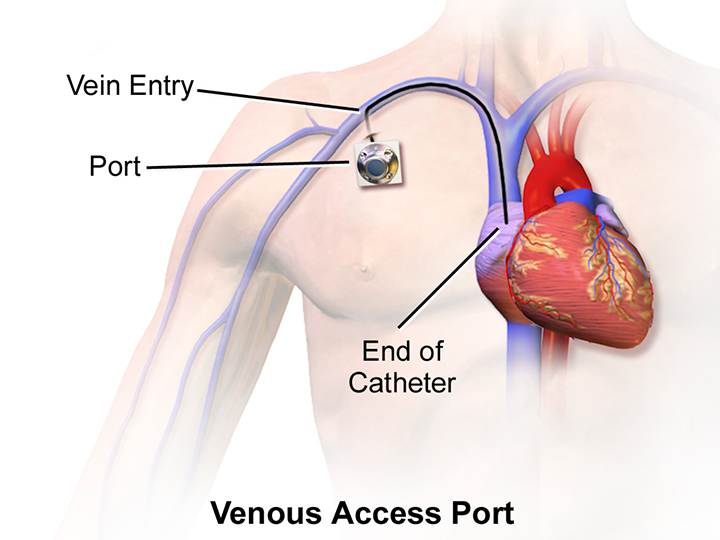What is a Venous Port?
A venous access port is a central venous access device that allows doctors to easily access your veins to give treatments and to take blood. It is made of a non-irritant material and is designed to be inserted under your skin and remain in place for weeks or months. It is also known as a subcutaneous infusion port and includes a catheter (a thin hollow tube), which is inserted through the skin and is then connected to a port in a pocket under the skin.
Venous access ports are commonly used in the care of patients with chronic liver disease, particularly cancer patients, and are considered an integral part of cancer therapy. The port provides reliable access for taking blood, blood transfusions and administering nutrition, fluids and medication with minimal disruption to the patient’s lifestyle. The venous access ports used today are light and can be used during imaging procedures.

What to Expect at Venous Port Procedure
The procedure for implanting a venous access catheter is performed on an outpatient basis, in our state-of-the-art oncology centers. Under fluoroscopic guidance, the port is inserted into the upper chest or arm. The interventional radiologist will access the vein under ultrasound guidance using a thin needle. The right internal jugular vein, which collects blood from your brain, face and neck, is the preferred vein for this as the risk of blood clots and pneumothorax (collection of air or gas in the space between the lung and the chest wall) is lower.
If you are receiving a port, the team will mildly sedate you, numb the area and make a small incision, and then place the port under your skin and into a vein.
After placement, they will put a small dressing. You will be given instructions about how to care for the implantation site while the incision heals. Pain medication may be given if it is necessary.
Your newly inserted venous access catheter or port is tested to make sure that it is working correctly before you leave. All incisions are properly cleaned, and adhesive dressings are applied.
What Are the Benefits of a Venous Port?
A Venous Port is ideal to provide a long-term yet intermittent intravenous access. You can receive chemotherapy or transfusions on a weekly or monthly basis and has many advantages over a catheter inserted into a vein in the arm or hand.
Although the placement procedure is more complex than the more common technique of inserting a catheter into a vein in the hand or arm, a central venous access port will allow you to continue your daily activities, such as bathing, swimming and exercise.
A venous access port has a lower risk of being dislodged than a catheter in the arm or hand. The port also requires fewer injections of heparin and fewer dressing changes. Because it is beneath the skin, it has an aesthetic advantage as well as a decreased risk of infection. Venous access ports maintenance and risk of infection are low.
What to Expect After a Venous Port Procedure
After your procedure, you can return home the same day and return to normal routine and activity quickly.
If you have received medications that made you drowsy for the procedure, it may take a few hours for the effects to wear off.
Venous access is considered a relatively safe procedure and complications are rare. You may have slight bleeding at the site, but you will be closely monitored by our team.
We’re Here to Help
If your doctor has advised you to receive a Venous Port or you are interested in learning more about a Venous Port Procedure, please call us at 855.870.4747. We are happy to work as part of your multidisciplinary oncology team and are experts in this procedure. We always do our best to work with your insurance provider to maximize your coverage.
